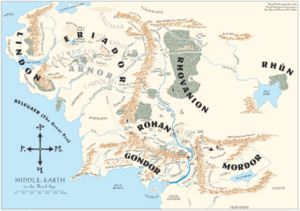Difference between revisions of "Middle-earth"
m (links) |
(Links) |
||
| Line 1: | Line 1: | ||
[[Image:Middle-earth.jpg|right|thumb|A map of the north-western part of Middle-earth at the end of the Third Age.|300px]] | [[Image:Middle-earth.jpg|right|thumb|A map of the north-western part of Middle-earth at the end of the Third Age.|300px]] | ||
| − | '''Middle-earth''' was the name given to the setting of a series of mythological stories written by Oxford Professor [[J.R.R. Tolkien]]. The name was derived from [[Midgard]]<ref>http://www.pantheon.org/areas/mythology/europe/norse/articles.html</ref>, the "Middle World" of Norse Mythology inhabited by people and located underneath Asgard (Norse Heaven) and above Hel (The Norse spelt Hell with one L). | + | '''Middle-earth''' was the name given to the setting of a series of [[mythological]] stories written by [[Oxford]] [[Professor]] [[J.R.R. Tolkien]]. The name was derived from [[Midgard]]<ref>http://www.pantheon.org/areas/mythology/europe/norse/articles.html</ref>, the "Middle World" of Norse Mythology inhabited by people and located underneath Asgard (Norse Heaven) and above Hel (The Norse spelt Hell with one L). |
| − | Tolkien did not create another Earth for his novels, although the shape of our lands have changed since the Third Age. Middle-earth corresponds to the Eurasian land mass, "east of the Sea." [[The Silmarillion]] tells of how the Noldor, immortal Elves from the West, invade Middle-earth on a quest for three | + | Tolkien did not create another Earth for his novels, although the shape of our lands have changed since the Third Age. Middle-earth corresponds to the [[Eurasian]] land mass, "east of the Sea." [[The Silmarillion]] tells of how the [[Noldor]], immortal [[Elves]] from the West, invade Middle-earth on a quest for three [[Silmaril]]s stolen by [[Morgoth]]. There they find the younger race of mortal Men, whose souls are not bound to Arda but depart beyond the circles of the world upon death. |
The First Age of Middle-earth ended with the defeat of the Vala Morgoth, who was cast into oblivion. However, in the Second Age, a [[Maia]] named [[Sauron]], who was the servant of Morgoth, rose to great power and took his master's place as the malign spirit opposed to everything good in Middle-earth. He was defeated by the Last Alliance of Elves and Men at the foot of [[Mount Doom]], and his great [[ruling Ring]] was taken from him by [[Isildur]] heir of [[Elendil]]. Sauron's body was slain and his vanquished spirit fled into the wilderness, which ushered in the [[Third Age]]. However in doing so the shape of the world was forever changed, the island of [[Numenor]] destroyed and the road to [[Valinor]] hidden. | The First Age of Middle-earth ended with the defeat of the Vala Morgoth, who was cast into oblivion. However, in the Second Age, a [[Maia]] named [[Sauron]], who was the servant of Morgoth, rose to great power and took his master's place as the malign spirit opposed to everything good in Middle-earth. He was defeated by the Last Alliance of Elves and Men at the foot of [[Mount Doom]], and his great [[ruling Ring]] was taken from him by [[Isildur]] heir of [[Elendil]]. Sauron's body was slain and his vanquished spirit fled into the wilderness, which ushered in the [[Third Age]]. However in doing so the shape of the world was forever changed, the island of [[Numenor]] destroyed and the road to [[Valinor]] hidden. | ||
Revision as of 01:55, January 15, 2008
Middle-earth was the name given to the setting of a series of mythological stories written by Oxford Professor J.R.R. Tolkien. The name was derived from Midgard[1], the "Middle World" of Norse Mythology inhabited by people and located underneath Asgard (Norse Heaven) and above Hel (The Norse spelt Hell with one L).
Tolkien did not create another Earth for his novels, although the shape of our lands have changed since the Third Age. Middle-earth corresponds to the Eurasian land mass, "east of the Sea." The Silmarillion tells of how the Noldor, immortal Elves from the West, invade Middle-earth on a quest for three Silmarils stolen by Morgoth. There they find the younger race of mortal Men, whose souls are not bound to Arda but depart beyond the circles of the world upon death.
The First Age of Middle-earth ended with the defeat of the Vala Morgoth, who was cast into oblivion. However, in the Second Age, a Maia named Sauron, who was the servant of Morgoth, rose to great power and took his master's place as the malign spirit opposed to everything good in Middle-earth. He was defeated by the Last Alliance of Elves and Men at the foot of Mount Doom, and his great ruling Ring was taken from him by Isildur heir of Elendil. Sauron's body was slain and his vanquished spirit fled into the wilderness, which ushered in the Third Age. However in doing so the shape of the world was forever changed, the island of Numenor destroyed and the road to Valinor hidden.
